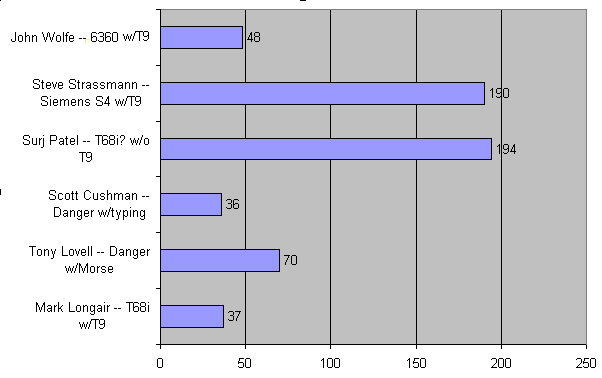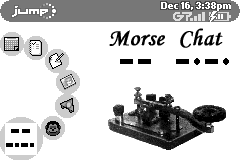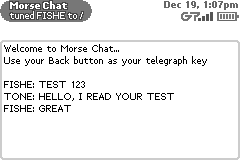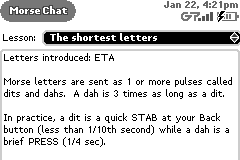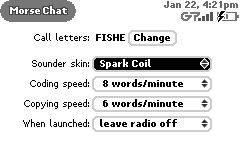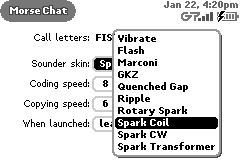User:Tone/CW
In 2003, while working at Orange Imagineering's Cambridge (Massachusetts), I created a Java applet and a Danger Hiptop (early smartphone) app to permit channel-based text chat where users could use Morse code or conventional typing.
I reproduce here a little document I created describing the work, including a 3D render of an imagined hardware device dedicated to the throwback medium I envisioned. It is important, when reading this, to realize that Orange was struggling to support a new subscriber community who were employing SMS to support Twitter-like broadcasts. Ultimately, I recall that Orange pulled the plug on the special support this community was receiving to enable their traffic, but it was catalytic in getting the wireless carrier to see that cell communications were continuing to evolve.
The CW Memo
Wireless SMS/IM/chat by Morse code.
Creating a quirky, unique community targeted toward youthful contrarians
Copyright Anthony Lovell, 2003
Document version: 2003Feb26_001
Project status: Unfunded. Prototypes developed for web and Danger Hiptop.

*Jogwheel on left accesses menu options.
* Small rocker on right is the "key" for encoding text as Morse.
* Speaker or vibrator can be used to receive
* LCD display offers a textual transcript of SMS and chat dialog
* Length: 3-3.5 inches ... slightly smaller than a T68
Among youthful subscribers, part of the appeal of text chat and SMS are their idiosyncratic natures. On mobile devices, composing and sending these messages with their arcane abbreviated argot is an intricate task with a considerable proficiency curve before one can use it efficiently. This project takes the fact that so many have successfully coped with the appreciable challenges of messaging over mobile phones as a sign that a subset of these users would respond to a device that took these challenges and made them a selling point rather than a design "issue".
The project's goal is to endow existing mobile devices and create new custom-designed devices with a Morse code text entry/output interface and allow them to tie into existing message-based communication networks such as SMS and IM as well as a new character-based chat medium in which each letter is transmitted as it is encoded.
The aim would be to recast the drawbacks of such an interface as a benefit: a user's proficiency becomes an mark of attainment demonstrable on bus, train, or barstool. The mysteriously retro but obstinant character of the interaction places its adopters into a self-selecting echelon. In a world where many kids indulge in body piercing or Trenchcoat Mafia-type affiliations as a expressions of identity, this might be more appealing than many would initially imagine.
Brand values and opportunities
Communicating by Morse would certainly mark the provider and user as dynamic and refreshingly different. However, the refreshing difference is achieved only in combination with the considerable liability of being comparatively harder to learn. But Morse also has a distinctive "spin" which a clever provider can leverage to help consumers see this as a challenge to be embraced in pursuit of -- and part of -- an image.
Morse code possesses a rich aura already firmly established in the minds of a global audience. It enters the scene armed with a compelling reputation: people know what it is, how it is used, and can think of historical scenarios of its use that smack of romance, danger, and intrigue. You don't have to manufacture this aura as you would with other products seeking to leverage the appeal it can bring to marketable brand. It is already pre-sold as an alluring emotional message with a conceptual recognition topping 90% in almost every market.
I envision ad copy redolent of Altoids campaigns: ads touting the selling points that Morse is powered by "electricity", that its messages get through faster than the Bristol packet steamer, and angry refutations of rumors that it is based on out-of-vogue enablers such as animal magnetism, is popular with phrenologists, or is likely to drive the popular carrier pigeon industry out of business (when, indeed, our company regards pigeon service as being complementary to wireless telegraphy).
Is Morse code a viable means of text entry?
From the standpoint of speed, certainly. A novice can send 12-16 words per minute and an expert can manage 25 WPM. A non-scientific time trial conducted in December 2002 asked competitors how quickly they could enter a test sentence into the handheld they used most often for text messaging: "I entered this text using my phone's keypad, as many users might"
The results had a lot of scatter. Availability of a full QWERTY keypad (even though small) offered a real advantage, and features such as predictive text entry were quite valuable when the text was in its dictionary (as this test was) and the user was experienced in its use. Morse entry seemed competitive with the best non-QWERTY entry models.
This chart obviously cries out for more data... specifically a more diverse set of SMS users with and without T9, and using test sentences that are in- and out-of-dictionary. Provisionally, I am comfortable with the competitive speed I demonstrated in my trial, as I am a novice at sending Morse.
From the standpoint of learnability, Morse code presents a challenge beyond that found in phone keypad entry. I am working to develop a "tutor" system on my prototype system to demonstrate how this could be done. To augment this, systems that include a qwerty keypad or a phone keypad can also be hybridized to permit conventional text entry modelessly alongside Morse entry. My prototype does this by allowing users to "type to send" text... others hear the characters arrive as Morse signalling as though they'd been manually entered.
A Prototype Client on an Existing Device
My prototype Morse Chat client runs nicely on the Danger Hiptop. This version is compatible with the Browser-based Java applet (no longer online, as my server is on a LAN) which runs in a variety of browsers running on Mac, Windows and Linux.
The Danger client lets users employ their Hiptops as handheld HAM radios with a global reach. They communicate with other users by Morse code, but automatic encoding and decoding options permit even non-Morse users to participate. The code is easily portable to Java-based devices.
Here is an example recording of someone sending "Hello, I read your test." over the device.[1]
Sadly, since T-Mobile has locked the Hiptops they sell, there is no means of installing and running the application on units running their released firmware, though this may change in future and allow a small test to be run.
Imagining a Dedicated Morse Wireless Device
Refer to the image at the top of this document for a render of what a small "palmable" radio might look like. The primary components include:
|
The device need not be a phone at all. The relative low bandwidth demands it imposes on the network would ideally be reflected in an affordable tariff for its service, and it would also be nice if manufacturing costs were low enough that they could be sold in our shops or even near the cash register at HMV or Abercrombie and Fitch.
The unique and focused functionality of this device might create the opportunity to gain a foothold in the lives of people who have not chosen to be our subscribers for their mobile phone. This should offer us a new opportunity to impress upon these wayward consumers that it offers a fresher and more appealing way of meeting their communication needs than other wireless providers.
Features and benefits realized in current prototype
- Fairly portable Java code, already boasts compatibility with many desktop platforms as well as the Danger. I hope it is an easy port to MIDP devices as the visual interface is minimal and can be reduced further.
- Morse code is actually fun... not unlike the satisfying fun of a crossword puzzle.
- Allows many-to-many live text chat.
- The "radio" can be "tuned" to any number of different, named channels.
- Users can encode text using a single button at speeds up to at least 20 WPM.
- Different sounder "skins" mimic various radios.
- Alternatively, users can silently read inbound traffic by LED flashes, through vibration, or even by reading the letters off the screen!
- Similarly, users not yet comfortable sending in Morse can type on the keyboard -- the pulses will be automatically generated as though they'd used the telegraph key.
- Because the device automatically decodes the sender's use of the key, his audience can simply read the text as it arrives as though they'd decoded it by ear.
- Users can configure their sending and copying speeds independently -- the device slows down incoming signals which were encoded at higher speeds than the local user can competently copy. This smoothes over disparate skill levels.
- Vibrate mode allows users to discreetly or even surreptiously chat or message.
- Protocol faithfully captures the exact timing of keypresses to allow receiver to hear pulses exactly as they were sent. Users quickly acquire a distinctive "fist" as useful in identifying themselves to friends as the sound of their voice over a telephone.
Potential features and benefits
- When these devices are tied to SMS/IM networks, adopters have access to a vibrant and large community from the first day, relieving the product from the initial pain of a networked technology (owning a fax machine when no one else owns one).
Next Steps
- I need to develop a friendly, interactive and evocative method to teach people Morse Code.
- Develop ties to SMS and/or IM networking to permit message-oriented communication with existing networks in addition to the current live chat communication on a proprietary network.
- Port it to a more humble MIDP phone to emphasize its suitability for devices of incredibly humble I/O capability
- Allow incoming signals to be displayed as Morse flag-waving, semaphore, and signal flags of various epochs
- Allow text to be sent by semaphore with the device's camera reading your manipulation of actual, physical flags
- Produce a "palmable" text chat/SMS/IM handheld such as that shown above
- Improve the heuristics of how the device decodes Morse signals from a given user in order to eliminate the need to configure a "sending speed".
Context for the Memo
The memo ended here. I had no place to take it, that I knew of. Though my title at the time was Entrepreneur in Residence, I was always a "design and vision guy", and not a huckster or corporate player. I had no one to help me address this skills gap.
That said, I did get my CW apps, on the web and on the Hiptop) integrated with my naval simulation project at the time, Fleet Action Imminent. I could tap wireless messages into my Hiptop, such as "QM steer west", and watch as the wireless operator aboard H.M.S. Queen Mary received the message, wrote it on a pad, and then called it out aloud. Upon hearing this received order, the simulated helmsman called out "turn west, aye!" and proceeded to alter course. This sort of connection to a gaming world remains part of my vision for how mobile apps and platforms can interoperate with rich games not directly suitable for them.
See Also
Footnotes
- ↑ Note: I am unable to locate this audio file after fifteen years.
